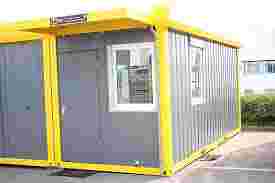construction containers In today’s fast-paced construction industry, efficiency, safety, and organization are crucial. One of the most practical innovations that meet these demands is the construction container. These versatile steel boxes are no longer limited to transporting goods across oceans — they’ve become a staple on construction sites for everything from storage to temporary office spaces. This article dives into why construction containers are vital for modern construction and how they contribute to more organized and cost-effective projects.
Understanding Construction Containers
Construction containers are heavy-duty, portable enclosures primarily made from corrugated steel. Initially used as shipping containers, they’ve been adapted to meet the needs of construction sites, offering a reliable solution for storage, office space, and more. Available in various sizes, including 10ft, 20ft, and 40ft options, they are engineered to withstand tough environments.
Why Construction Containers Matter
Improved Site Organization
Construction sites can be chaotic with tools, materials, and documents spread across large areas. Containers centralize storage, helping crews stay organized and locate items quickly, boosting overall productivity.
Enhanced Security
Containers come with reinforced doors and locking systems to protect valuable tools and materials. Their solid steel walls are almost impossible to break into without heavy equipment, acting as a strong deterrent against theft.
Temporary but Reliable Workspaces
Many contractors convert construction containers into fully functional office units or break areas. These spaces can include desks, lighting, insulation, and HVAC systems, offering a quiet place for meetings, planning, and administrative tasks.
Different Uses of Construction Containers
Material Storage
Containers are ideal for storing construction materials such as bricks, cement, insulation, and piping. This protects materials from weather damage and theft.
Tool and Equipment Storage
Rather than leaving tools exposed to the elements or scattered across the site, workers can safely store power tools, ladders, and safety gear in containers.
Mobile Offices
These units can be customized with electricity, internet, and furniture, providing a productive space for supervisors and engineers.
Break Rooms and Welfare Units
Modified containers can include seating, kitchenettes, and restrooms, meeting worker comfort and health standards.
Key Advantages of Construction Containers
1. Portability
Containers are designed for easy relocation. Whether by crane, forklift, or truck, they can be moved as needed to match the progress of a project.
2. Cost Savings
Compared to constructing permanent buildings on-site, containers are a budget-friendly solution that can be reused across multiple projects.
3. Fast Deployment
Construction containers can be delivered and operational within hours, making them a quick fix for urgent storage or office space needs.
4. Weather Protection
Sealed and insulated options protect contents from rain, wind, and extreme temperatures, ensuring site materials remain in top condition.
Environmental Impact and Sustainability
Repurposing old shipping containers for construction use supports sustainable building practices. It reduces the need for manufacturing new temporary structures and minimizes waste. Many containers are also outfitted with solar panels or eco-friendly insulation, contributing further to environmental conservation.
Conclusion
Construction containers are far more than simple storage units — they are adaptable, secure, and sustainable solutions that play a vital role in today’s construction industry. Whether it's improving site logistics, protecting equipment, or providing mobile offices, their benefits are clear. As the demand for efficient and green building solutions grows, the use of construction containers will undoubtedly continue to expand across job sites worldwide.
For more…construction containers




